Market Analysis
In-depth Analysis of Deformity Market Industry Landscape
Deformity market covers the spectrum of musculoskeletal disorders which include congenital deformities, deformities caused by injury or disease, and deformities that occur with age, like osteoarthritis. Market dynamics are determined by the frequency and intensity of those diseases among various populations. Variants of therapy for musculoskeletal deformations depend on that kind as well as the stage of the disease. In mild deformities, nonoperative measures, i.e., physical therapy and bracing are advised, and in moderate to severe deformities, operative measures, i.e., corrective osteotomy and joint replacement are to be considered. Orthopedic implants evolution including custom implants and 3D printing brings personalized therapy for difficult musculoskeletal deformities. The new technologies bring the market dynamics because they provide more individual approaches. The deformity market can be categorized into several classes such as the deformity type- spinal deformities (scoliosis, kyphosis), limb deformities, joint deformities. Each part provides a variety of concrete issues and viewpoints to the medical device manufacturers, healthcare providers, and other stakeholders. The economic costs of musculoskeletal deformities as an economic burden include costs of healthcare for diagnosis, treatment, rehab, and indirect costs due to loss of productivity aftermath of disability. Economic factors dictate the market dynamics such as pricing strategies and reimbursement policies. The approval processes and commercialism of orthopedic devices and surgical treatments for musculoskeletal deformities are governed by the regulatory agencies such as the FDA in USA and EMA in Europe. Compliance with regulatory requirements is the condition for entering the market and answers the general market attitude. Deformity market is a stressful market as there are many players including medical device companies, orthopedic surgeons and rehabilitation specialists. Product innovation, market penetration, and alliances are some of the determinants of market dynamics. Technological breakthroughs like robotic-assisted surgery and navigation systems are changing the scenario of deformity management with the improvement of surgical accuracy and outcomes. The innovations progress the market dynamics by enhancing the efficacy and efficiency of the treatment options. Some of the causes of investment in research and development projects for musculoskeletal deviations are market forces, technological advances and government aids. Financing of innovations in the deformity market is provided by government organizations, venture capital firms, and nonprofit institutions.

















Leave a Comment